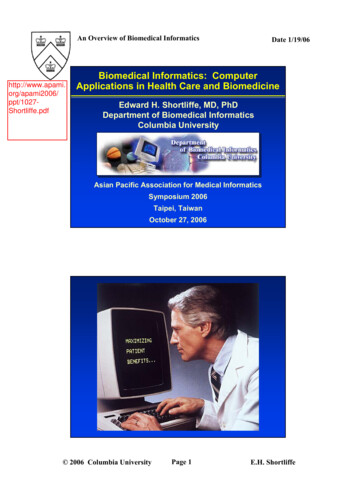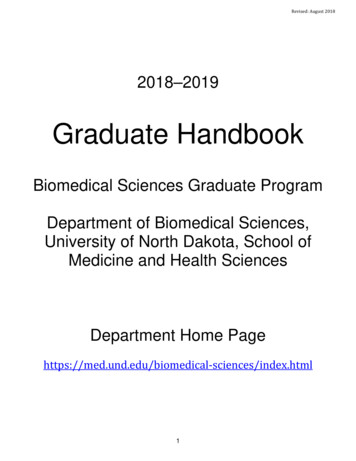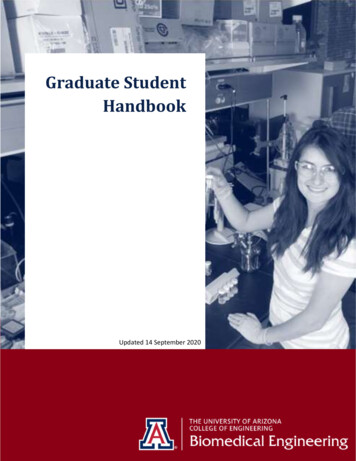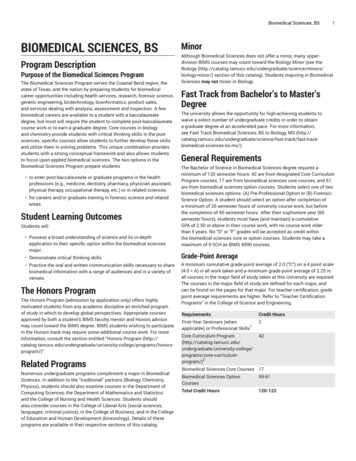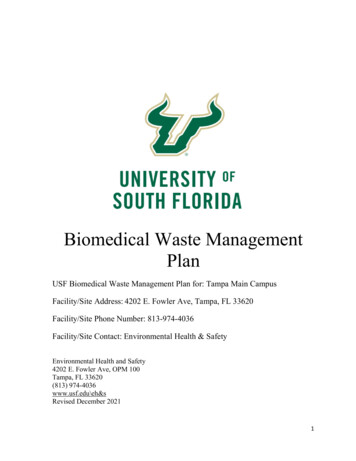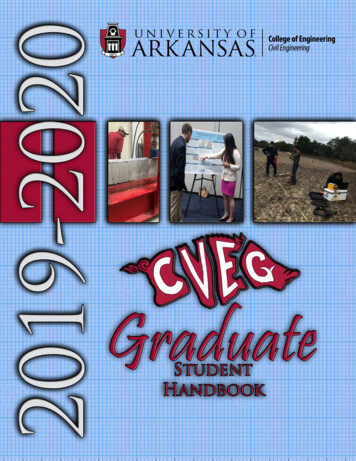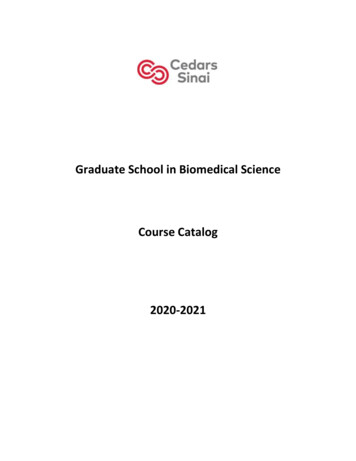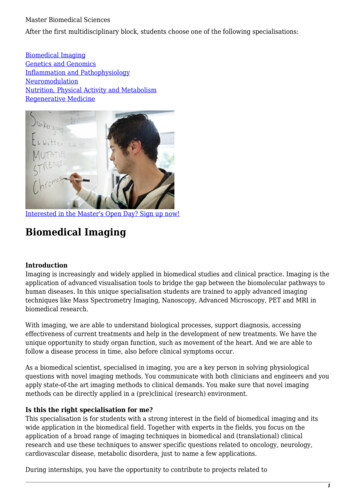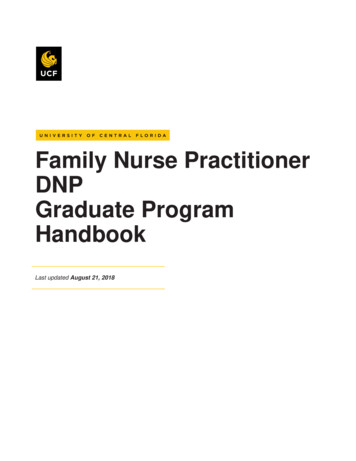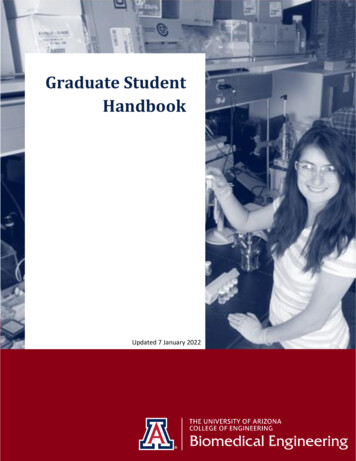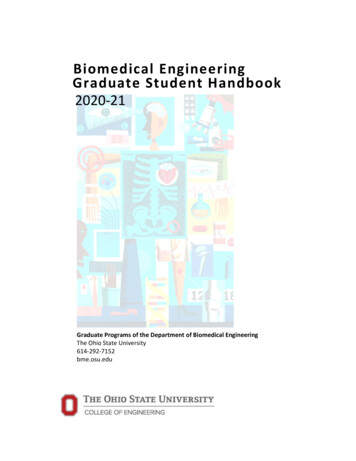
Transcription
Biomedical EngineeringGraduate Student Handbook2020-21Graduate Programs of the Department of Biomedical EngineeringThe Ohio State University614-292-7152bme.osu.edu
Table of ContentsSECTION 1: Graduate Program Advising & Governance1SECTION 2: Registration and Enrollment Basics6SECTION 3: Programs of Study: How to Create an MS or PhD Program of Study and Get it Approved by the BMEGSC9SECTION 4: BME Thesis-MS Curriculum Requirements11SECTION 5: Thesis-MS Committee and Examinations13SECTION 6: BME Non-Thesis-MS Curriculum Requirements15SECTION 7: Non-Thesis MS Committees and Culminating Experience17SECTION 8: BME PhD Curriculum Requirements19SECTION 9: PhD Candidacy Examination: Overview, Committee, and Process21SECTION 10: PhD Dissertation Defense: Final Oral Examination Overview, Committee, and Process25SECTION 11: Combined Medical Scientist Training Program: MD/PhD Degree28SECTION 12: Combined BS/MS Program in BME30SECTION 13: Funding Sources and Policies33SECTION 14: Student Organizations, University Services & Wellness Resources35SECTION 15: Development of Ethics in Scholarly Activities38SECTION 16: MS and PhD Application & Admission Requirements40Appendices to BME Handbook44List of Graduate Courses for Programs of StudyPhD Program TemplateThesis MS Program TemplateNon-thesis MS Program TemplatePhD Timeline: Completing degree requirementsMS Timeline: Completing degree requirementsPhD Graduation ToolMS Graduation ToolAdmission Prerequisites for Non-engineersDepartment MissionDepartment History & Background
PURPOSEThe purpose of the Biomedical Engineering Graduate Student Handbook is twofold: to amplify the Graduate SchoolHandbook (GSH) published by the Graduate School of The Ohio State University, and to provide additional informationregarding the programs and activities of the Department of Biomedical Engineering.The Graduate School Handbook (GSH) provides critical information for all prospective and current graduate studentsat The Ohio State University and is available at the Graduate School website https://gradsch.osu.edu/handbook.The material in this guide is prepared by the Biomedical Engineering Graduate Studies Committee (BMEGSC) andGraduate Program Coordinator to clarify Departmental policies. Where appropriate, it has been approved by theDepartmental Faculty via the Biomedical Engineering Graduate Studies Committee (BMEGSC) and is subject to theinterpretation of that committee.Additional important university policies and dates can be found at at buckeyelink including links to the Course Catalog,Schedule of Classes, and University Registrar websites.It is the responsibility of all graduate students (including combined degree students) to know and follow all GraduateSchool and Biomedical Engineering policies. During this time of personal and professional growth, graduate studentsare expected to be self-motivated to fully utilize all resources available for success in Graduate School. It will requireinitiative and the ability to read carefully and proactively. As well, it will require the building of many different types ofrelationships with classroom peers, lab mates, professors, faculty advisors, faculty supervisors, and program staff.Research toward MS and PhD degrees may be conducted in any of the research areas associated with our manygraduate faculty. Explore the BME website for a current list of graduate faculty and research areas.Interdisciplinary and inclusive collaboration is a hallmark of biomedical engineering. There will be differences amongthe policies and procedures set forth by different graduate programs and colleges: for example, differences may existsamong recruitment, qualifying conditions, examinations, funding options, curriculum approval/protocol, and stipendranges, etc. Please understand that much may vary among units while operating within parameters set forth by theGraduate School. The policies and practices described here have been carefully designed both to benefit and to befollowed by all biomedical engineering graduate students.Professors Rich Hart (left)and Samir Ghadiali(middle) provide seamlessleadership as past andpresent BME DepartmentChairs; Past BMESPresident, DormaFlemister, thanks Prof.Hart for his service from2006 – 2018.
Biomedical Engineering Graduate Student Handbookrev Dec10; Jun12; Aug14; Aug15; Aug20SECTION 1:Graduate Program Advising & Governance1.1 Faculty Core Contacts & Performance StandardsWhen a student has been admitted to the Graduate Program in Biomedical Engineering, a student is assigned a "core BMEfaculty contact" from among the departmental faculty. This “core contact” is a BME faculty member who serves as anacademic advisor, different from the staff person most students consulted in undergraduate years. A “core contact” maydouble as the student's research advisor. Core contacts provide in-depth course advice and referrals, or they may functionas a sounding board, or to help a student brainstorm. They periodically may be asked by the BMEGSC to evaluate a student'sacademic performance to assess reasonable progress, though it is the student’s responsibility to initiate contact andrequest feedback on goals and performance. Students are encouraged to make regular contact with these assigned facultyresources and are welcome to switch to another faculty member as stronger, more natural relationships develop over time.EXTRA MENTORSHIPMeeting regularly with your core contact is a built-in way to forge a significant relationship with a facultymember who is commited to helping and who is not necessarily supervising or involved in your research.1.2 Maintaining Satisfactory Academic StandingTo be in good academic standing in the Graduate School, a student must maintain a graduate cumulative point-hour ratio(CPHR) of 3.0 or higher in all graduate credit coursework and must maintain reasonable progress toward degreerequirements. Achieving this requires open communication with research advisors; the establishment of clearexpectations; and a necessary balance among research, coursework, and wellbeing.Sources used to judge reasonable progress include:1. Cumulative point-hour ratio2. Research advisor’s/core contact’s recommendations3. Thesis or dissertation committee members' recommendations4. The PhD Student Annual Review formA student’s research advisor and/or core contact should apprise the BMEGSC of any student judged not to be makingreasonable progress. If the BMEGSC concurs, the student will be notified of such in writing, with an explanation of thereasons for this judgment; actions that the student can take to remedy the situation; and a time limit for rectification. Thetime limit in most cases will be no less than two terms.Failure to maintain reasonable progress will result in a recommendation to the Graduate School by the BMEGSC that thestudent be denied further registration in the program. This type of break has been known to help students in academictrouble by providing a mandatory opportunity to prioritize wellness. A request to be re-instated can be made by the studentat a future time, when the student is in a better position to succeed.A doctoral student who has had two unsatisfactory attempts at the Candidacy Examination or the Final Oral Examinationor Professional Doctoral Examination is not considered to be in good academic standing and may be dismissed from theprogram per Graduate School rules.1
1.3 Selecting a Research AdvisorParticipating graduate faculty (many from outside departments and colleges) have diverse research interests and act asresearch advisors to graduate students, along with those who call Biomedical Engineering their home unit. While thestudent’s assigned core contact fulfills a sort of “helper” role, the research advisor is the main advisor and mentor (andoften also functions as Graduate Research Associate GRA supervisor). When a research advisor is new or from an outsideunit, a student’s core contact can be an invaluable resource for advice on BME culture and practices.Research advisors and students will work together to define research projects and to develop the program of study and toform an advisory (i.e., examination) committee. For an MS student, the research advisor chairs the MS ExaminationCommittee. For a PhD student, the research advisor chairs the Candidacy Examination Committee and the Final OralExamination Committee.Selecting a research advisor is one of the most important decisions students will make during the course of their graduatecareer. It is important that students take time when choosing their research advisors because they will be a key componentin a student’s success at the graduate level. It is important to be aware of a research advisor’s working style. Talking withcurrent students who work in faculty labs and asking questions about style, funding, and expectations can help newstudents make proper choices.The research advisor of a master’s student must hold membership at the Category M level or higher in BiomedicalEngineering. The research advisor of a doctoral student must hold membership at the Category P level in BiomedicalEngineering. Questions about graduate faculty status may be directed to the Graduate Studies Office.For details on graduate faculty duties and responsibilities, see Section 12, GSH.Students are strongly encouraged to begin seeking an advisor and research project as soon as possible. Sometimes thisautomatically happens as a result of funding and project connections made early in the admission process. Others (e.g.,fellowship recipients, etc.) may choose to do informal rotations in multiple faculty labs before identifying a researchadvisor. Regardless, students should select an advisor by the end of their second term of enrollment in the graduateprogram.Q: How does a Faculty Member get Graduate Faculty Status?If a faculty member with whom you seek to work does not have graduate faculty status, they can apply for itby writing a letter addressed to the BME Graduate Studies Chair along with a current CV, emailed to theGraduate Studies Coordinator for consideration at the next convened BMEGSC meeting. Letters should includea statement of the faculty member’s goals in working with BME graduate students; ability to fund graduatestudents; and past graduate or engineering advising experience. Graduate Faculty requests are processed 2-3times per year.1.4 Student ResponsibilityStudents are responsible for developing programs of study and forming their necessary faculty committees, and for seekinginput from faculty core contacts and research advisors. It is the responsibility of the student to enlist the participation offaculty on their committees and to consult with their faculty advisors on a regular basis. It is the graduate student’sresponsibility to know and follow all departmental and university procedures and deadlines and to submit all BMEGSCrequests for approval in a timely fashion, anticipating delays during busier points in the academic year.Interaction between students and their research advisors will vary. Some may have daily contact and others may consultweekly or even less frequently. To ensure that degree requirements will be met efficiently, remember to be proactive andsee your research advisor and/or core contact regularly to: Discuss concerns, your research project, opportunities, and problems2
Ask for help to determine your course scheduleGet approval for projectsGet ideas and coordinate plans to apply for external funding and fellowshipsInitiate the PhD Student Annual Review form and review with advisor/core contact (for PhDs only)PhD Annual Review Forms are due to the Graduate Studies Office by May 31 each year. Students must complete them forreview with their research advisor and/or core contact. All must sign to verify that a review has taken place. The purposeof this exercise is to provide an opportunity to reflect on progress, make changes, and set new goals.For more information on good standing and responsible student conduct, see Section 5, GSH.Not all research advisors are GA supervisors, but often they are the same person. Below is a reminder of the different rolesyou and your faculty supervisor may hold.Balancing Roles & ociateSatisfactory academicprogressSatisfactory performanceThesis orLab or teachingdissertation researchtasks & activities1.5 Biomedical Engineering Graduate Studies Committee (BMEGSC)The graduate programs in Biomedical Engineering are administered and governed by the Biomedical Engineering GraduateStudies Committee (BMEGSC) under the guidance of the Graduate School and Faculty. They are the local body that reviews& approves academic and curricular matters at the Department level before we send them on to the Graduate School, theOffice of Graduate Admissions, or the Registrar (i.e., the University level).The BMEGSC must approve all admissions, funding arrangements, proposed programs of study and faculty compositionand membership of all examination committees required by the Graduate School. They review faculty requests for“graduate faculty status” as well as anonymous program assessment information gathered via faculty and student surveys.The 8-10 faculty members and Chair of this committee are appointed by the Department Chair from the departmental andparticipating graduate faculty in Biomedical Engineering. The membership includes the Graduate Program Coordinator anda student representative (an elected BMEGSA Officer) who along with the Graduate Coordinator acts as a liaison betweenthe student body and the committee. The Chairperson of the BMEGSC authorizes the business of the committee, whichmeets regularly throughout the year to fulfill the responsibilities delegated to it by the Graduate School (see Section 13,GSH). The Graduate Studies Coordinator assists the BMEGSC, graduate students, and tracks agenda items.3
Students who have communicated with their core contacts and faculty advisors about problems may bring requests andconcerns directly to the attention of the BMEGSC for their advice and consideration by a larger body. Requests about coursewaivers or substitutions must always be accompanied by a proposed program of study, along with the requisite syllabi. Fordetails on preparing the Program of Study, see section 3 of this Handbook. Correspondence addressed to the “Chair of theBME Graduate Studies Committee” should be directed to the Graduate Studies Coordinator by email at least one full weekin advance of any scheduled meeting. Meetings typically are held once monthly and business agendas fill quickly.1.6 BMEGSC Seasonal Working Calendar: Autumn through SpringWhen submitting requests to the BMEGSC, students should be aware of the seasonal BMEGSC workload. The committee’sprimary business typically falls as listed below. DEC-FEB: Review and make admission decisions on applications; JAN-MAR: Make funding connections, prepare fellowship nominations and events; Visit day MAR-MAY: Review student proposed programs of study and/or transfer requests; JUN-JULY: No BMEGSC meetings; annual reviews; orientation; revisions AUG-MAY: Evaluate individual requests for unplanned exceptions to program requirements, review graduate facultystatus, manage graduate assessment, review curriculum, and much more. SEPT-NOV: Recruitment; GEOH; BMES; scheduling issuesGraduate Studies Chair, Professor JunLiu, with doctoral student and 2020-21BMEGSA President, Jordan Moore.4
WHERE TO FIND HELP IN BME:FIRST-LINE RESOURCES & CONTACTS FORGRADUATE STUDENTSFor general questions about the graduate program, courses,fellowship funding, advisors, how to file BMEGSC requests,transfers, curriculum requirements, registration and lateadd/drop policies, getting involved with BMEGSA, studentorganizations, graduate faculty status, and other universityresources and wellness/support services: Graduate Program Coordinator, Melanie Senitko –senitko.1Graduate School WebsiteFor content-specific course and program questions, forming acommittee, learning more about labs, or proposing a researchcollaboration: Core Contact, Research Advisor, or GraduateStudies Chair, Jun Liu – liu.314For general advice on local Columbus living, BME graduatestudent culture, finding research resources, and help navigatinggraduate school processes: BMEGSA Officers, Current Students, or GraduateProgram Coordinator, Melanie Senitko – senitko.1For questions about your BME GRA contract, your hiringpaperwork, your employment benefits, how to order supplies,get a copy code, or other business-related matters: Department Coordinator, Jada Harmon –harmon.105Department Business Manager, Kirsten Gibbons –gibbons.40If not hired thru BME, you must work with yourGRA Supervisor’s HR officerFor keycard access to computer labs: Building Coordinator, Ben Jones – jones.182For local computing, systems, or AV issues: Systems Manager, Jerry Heskett – submit a workticket here5
SECTION 2:Registration and Enrollment Basics2.1 Registration and Credit Hour MinimaCourse registration is done online using Buckeyelink. Each currently enrolled student will obtain a registration “window”from the University Registrar. Students will schedule courses using the Course Catalog and Schedule of Classes, as well asthe semester Biomedical Engineering course list on the BME website. Students may take courses offered by all departmentsand may search their offerings also. All students must complete an initial schedule in advance of the term, meeting Registrardeadlines and required Graduate School credit minima in order to avoid late registration and payment fees or fundingproblems.REQUIRED ENROLLMENT TOTALS:Fellows: 12 credit hours per semester (6 in summer)Graduate Associates: 8 credit hours per semester (4 in summer)Post-Candidates: 3 credits per semester, continuouslySelf-funded Students: 8 credit hours per semester unless otherwise stipulated by visa, financial aid, orloan providersGraduating Students: 3 credit hours in graduating semesterTypical Courseload for many MS or pre-candidacy PhD students: 12-15 credit hoursStudents signing up for BME 8193 (Individual Studies) and BME 8999 (Research) must obtain the required call numbersfrom the BME Graduate Studies Office in order to register each term. These numbers change each term. Students shoulddiscuss research hours, their schedule plans, and any schedule changes with their core contacts and research advisors eachsemester.Students are responsible for learning all relevant dates (which dictate the types of schedule changes, adds, and dropspermitted) as well as all necessary procedures and paperwork, as stipulated by the University Registrar. Students mustfollow their helpful registration calendar each semester. Failure to do so can cause expensive penalty fees.2.2 Registration Pre-requisites and Special PermissionsStudents may make adjustments to their schedules electronically through the first Friday of the term. Note that someschedule adjustments (i.e., dropping credit hours) will require the addition of other courses in order to maintain the credithour totals required for fulltime enrollment and funding. A best practice is to register for 15 or more credits total so that ifyou run into trouble and must drop courses past the course add deadline, you will not be in danger of dropping below thecredit hour minima for your fellowship, GRA, etc.Students attempting to add a course may receive error messages regarding pre-requisites. Sometimes a class is full;sometimes there is a slight time overlap between courses; sometimes the course is open only to majors. Whatever thereason, cases like this will results in error messages. In such cases, a student should do the following: 1) contact theinstructor teaching the course; 2) obtain email approval from the instructor to add the desired course (“OK to add withoutpre-reqs” or “OK to add over the seat limit”); and 3) submit the email to the Graduate School or senitko.1@osu.edu in theBME Graduate Studies Office in accordance with the posted deadlines.All of the following information must be included, with written instructor permission for any add request, and must be sentfrom a student’s official osu.edu email account:1) course title and number2) section call number – most important6
3) instructor4) credit hoursFERPA – protect your rights by using your official buckeyemail.OSU.EDU emailaccountAll requests made of Ohio State offices – should be made from the student’s buckeyemail.osu.edu account to helpus ensure that your FERPA rights are being protected. Students should not email university offices from their gmailor other accounts. In the rare case that this must happen, it is important that a student include their NAME.#@buckeyemail.osu.edu address in the body of the message.2.3 Continuous Registration for Post-CandidatesAll PhD students who successfully complete the doctoral candidacy examination are required to be enrolled for at least 3credits in every semester following (excluding summers) until graduation. This policy is effective for all students who wereadmitted to the Graduate School Autumn Quarter 2008 and after. Harsh penalty fees for those who do not registercontinuously will be assessed. Be sure to avoid problems post-candidacy by making sure to sign up for the proper numberof credit hours (3) by the appropriate deadline.2.4 Registration MaximumThe maximum number of hours permitted by the Registrar’s Office is 18 credit hours per semester. Enrollmentgreater than 18 credits must be approved by the student’s research advisor and the Graduate School.2.5 Courses that Count for Graduate CreditCourses that count for graduate credit must be 5000-level and above. In Biomedical Engineering, courses were designed tomeet the needs of advanced undergraduates as well as graduate students; therefore, we list many at 5000-level. Manygraduate programs feature graduate courses in the 6000-, 7000-, and 8000-levels. All of these are appropriate on aBiomedical Engineering graduate program of study, pending research advisor and BMEGSC-approval.2.6 Defining and Planning the Distribution of BME Research CreditsThe number of research credits (BME 8999) that can be taken after Candidacy is usually limited to 3 credit-hours eachsemester. Students will want to plan ahead and maximize the number of BME research credits taken before Candidacy, toavoid being forced to take extra time to fulfill total program credit requirements. Note that all credits taken above 8 in agiven semester are the same cost. Also, all research credits should be taken under a BME course section unless the primaryresearch advisor’s appointment is in another engineering department. If the latter is true, then at least ½ of the researchcredits must be taken in BME.A handy rule of thumb for scheduling research credits is to allow for 3 outside hours of work weekly for each single creditscheduled. That means if you take 4 BME research credits, you may be putting in roughly 12 hours of effort per week onresearch. However, expectations shared between research advisor and student are most important and take precedenceover this equation. Some advisors may wish their students to take as many research credits as possible in the first fewsemesters; this is OK as long as both advisor and student have a clear understanding of the student’s required course loadand obligation to maintain a strong GPA.After candidacy, when PhD students are expected to take only 3 credits per semester, the time spent on dissertationresearch-related work actually will be much greater than 9 hours per week. For this reason, it is helpful to think of researchhours and expectations of effort as a multi-year combination of “best practices” and a “work ethic” agreed upon by facultyand student. The whole of a student’s efforts will combine over all of the semesters enrolled to amount to at least 45credits of research-related progress. For most, research goals naturally will take priority over credits and will be the guidingprincipal. PhD students will have a chance to get and give feedback on progress and expectations by completing a requiredannual review with their research advisors.7
RESEARCH CREDITS, GRA DUTIES & RESEARCH GOALS:SEPARATE BUT RELATEDThe academic efforts of a graduate student described above may or may not overlap with theresponsibilities and duties of a Graduate Research Associateship (GRA) appointment. Therequirements of a GRA appointment are contingent on satisfactory performance of a student’s degreerelated pursuits. However, GRA responsibilities may or may not be related to the student’s thesis otdissertation. (This often is why one student’s perceived commitments or time spent in the lab maylook different than another’s.) For a GRA appointment, the student receives tuition coverage and astipend, and is required to do 20 hours per week of activities and tasks related to the appointment.The student develops technical skills and other professional skills holding this associateship.The student’s performance in a GRA role is evaluated annually by the research supervisor in a seperateHR-initiated review. For more information on GRA and GTA appointments, see sections 9 and 11, GSH.Caitlin Jones,doctoral studentand GRA in theLeight Lab, tooktop prize in the2020 HayesGraduate ResearchForum and nowholds apostdoctoralposition atNationwideChildrens Hospital.8
SECTION 3:Programs of Study: How to Create an MS or PhD Program of Study and Get it Approved by the BMEGSC3.1 Program of StudyIn consultation with their r ese ar c h advisor (and with input as needed from the core contact), a proposed MS or PhDg raduate Program of Study (i.e., course plan) is required to be submitted to the BMEGSC for approval before the end ofthe second Autumn semester.The selection of courses is individually tailored to the student's background, interests, and research and is organized byfour basic areas: Required Courses; Fundamental Courses; Electives; and Research. The distribution of engineering and lifescience courses must be appropriate for each individual student's program, as determined by the advisor, in accordancewith BME curriculum requirements.Curriculum requirements for the MS and PhD programs can be found in sections 4, 6, and 8 of this Handbook, along withsome sample program “skeletons”.Customizable templates exist for the purpose of formatting proposed Programs of Study: to help organize the courses inorder to more easily determine whether or not all requirements have been met. They are available here in the appendicesand on the BME website.The BMEGSC may accept any or all of the 30 semester credit hours from an earned MS degree (or from prior MS/PhD work)toward the PhD degree course requirements on the recommendation of the student's advisor. However, the fit of thetransferred courses into the program template is more important than the number of credit hours. Generally, students willnot use all transferred credits toward the program of study even if they are accepted to appear on the student’s transcript.The Program of Study must include a brief cover letter and must be signed by the student’s advisor and examinationcommittee members before the student submits it to the BME Graduate Studies Coordinator (by email to senitko.1)for review and approval by the BMEGSC. MS Examination Committees require 2 faculty. PhD Examination (Candidacy) Committees require 4 faculty.For detailed information on MS (thesis) and PhD (candidacy and dissertation) committees, see sections 5, 7, and 9 of thishandbook and sections 6 and 7 of the GSH.Individualized study courses (e.g., BME 8193) can be taken with a faculty member for course credit on any topic not coveredby an offered course in adequate depth. With documentation (i.e., a syllabus) students may request that these be used inprograms of study as electives, with BMEGSC approval.In developing and approving student programs of study, the BMEGSC will recognize and respond to the needs of studentswith physical and/or learning disabilities.Students entering the PhD program from the MS program should submit their proposed program of study to the BMEGSCwhen requesting admission to the PhD.Once a Program of Study is approved, any changes in courses, advisors, or examination committee membership must againbe requested of the BMEGSC at least one term in advance of the intended examination or term of graduation.9
After a Program of Study approval, transferring external credits to Ohio State is a one-step process requiring completion ofa transfer request form on the gradforms.osu.edu system. This form should not be completed until the student hasconsulted with the BME Graduate Program Coordinator. Students may email the form along with an official transcript withofficial degree statement to the BME Graduate Studies Coordinator for review. Once approved it will be forwarded to theGraduate School for final approval and processing.3.2 B M E G S C Petitions and Special RequestsIf a student wishes to request a course substitution or exception to the rules, special requests will be considered by theBMEGSC. Students should petition for these changes in the program of study cover letter (or in a separate letter ifrequested after the original program approval) with a signature of support from the student’s advisor. If the request refersto external courses, course descriptions and/or syllabi must be included.3.3 Steps to Submit a Program of Study for Approval1. The student must complete the template, filling it in with all planned courses and research credits required tomeet the degree requirements.2. If transfer courses or exceptions are requested, syllabi must be attached.3. The student must get the approval of the advisor, as well as the MS or candidacy committee, who must sign theprogram or send an email of approval. It is the student’s responsibility to gather and compile all approvals forinclusion with the
It is the responsibility of all graduate students (including combined degree students) to know and follow Graduate all School and Biomedical Engineering policies. During this time of personal and professional growth, graduate students are expected to be self-motivated to fully utilize all resources available for success in Graduate School.
